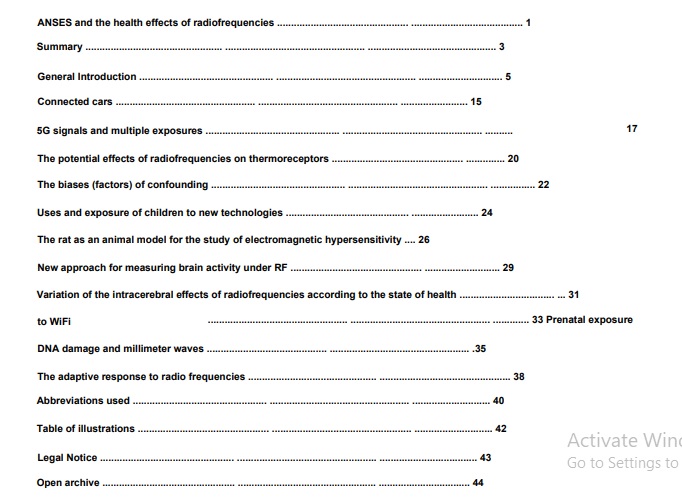In French:
Cahier de la recherche n°20: “Radiofrequencies and health – Understanding where research stands (PDF)
Machine Translated by Google:
https://www.emfsa.co.za/wp-content/uploads/2022/11/22-11-ED-Cahiers-de-la-recherche_20-2.pdf
ANSES – Research Papers No 20 – Health, Environment, Labor – November 2022
Radiofrequencies and Health: Understand where the research stands May 2021-November 2022
ANSES and the health effects of radiofrequencies (translated)
Development of communications technologies translates into a wide variety of objects, connected devices and wireless services using radio frequencies: baby monitors, security cameras headphones, glasses, watches, key rings, blood pressure monitors… This exponential growth is not without raising questions that are the subject of permanent news both from a scientific and regulatory point of view and from a political and societal point of view.
The growth in uses is likely to increase the exposure of the general population via new fixed transmitters, new mobile equipment or new uses (e.g. equipment worn close to the body, even inside the body or even the skin).
For several years, ANSES has been involved in expert appraisal activities in almost all areas of the
non-ionizing electromagnetic spectrum: from extremely low frequencies to millimeter waves. With
regard to the deployment of 5G technologies, the Agency collaborated with the ANFR to collect the
first public exposure measurements taken before and after the commissioning of 5G on 1,500 sites
located in France. In addition, from 20 April to 1 June 2021, it carried out an open consultation during which citizens could make contributions and comments on the expert report published in April 2021. Hence ANSES’s updated opinion of February 2022 supported by an expert report supplemented and enriched with new data.
In view of the rapid evolution of technologies which leads to the exploitation of new frequency
bands (such as those of 3.5 GHz and 26 GHz for 5G, in France), it seems essential, on the one hand,
to adapt the methodologies for measuring and evaluating exposure and, on the other hand, to study the biological and health effects of electromagnetic waves in these frequency bands. To date, the number of users and 5G traffic are still limited in France in the 3.5 GHz band, while the 26 GHz band is not yet exploited by mobile telephone operators. ANSES’s mission is part of a developing context and the data available in the literature are still scarce.
To estimate the impact of 5G technologies on health and the environment, the Agency regularly
continues its scientific monitoring and updating work. Following the recent production of numerous
data from new mechanistic studies, but also from epidemiological studies such as Mobi-kids
(December 2021) or the key study of the “National Toxicology Program” (August 2020) on the
development of tumors in rodents exposed to mobile telephone signals, an expert appraisal
examining the carcinogenic effects of radiofrequencies is underway at ANSES, all frequency bands
combined.
Finally, ANSES invests in the production of new scientific knowledge by supporting research on the health effects of radiofrequencies. This Cahier de la Recherche presents eleven projects funded between 2017 and 2020 via the call for research projects; “radiofrequencies and health” of the national environment-health-work research program (PNR EST). So-called exploratory investigation projects (PIE) also make it possible to acquire new knowledge in response to questions raised by civil society, for example on the symptoms declared near relay antennas, hypersensitivity to electromagnetic fields or even the exposure to new mobile telecommunications signals including 5G. The need for this type of project was identified thanks to the dialogue initiated since 2011 with associative or professional stakeholders within the framework of the “Radiofrequency and health” dialogue committee.
Professor Benoit VALLET
Director General, ANSES
Notebooks of the research on the Agency’s website: https://www.anses.fr/fr/content/les-cahiers-de-la-recherche
Note to readers: The presentations of the research projects reflect the points of view of the partner scientific teams and do not commit either the supervising Ministries or ANSES and the associated partners. For any questions, the contacts are indicated at the top of each article.
Summary

